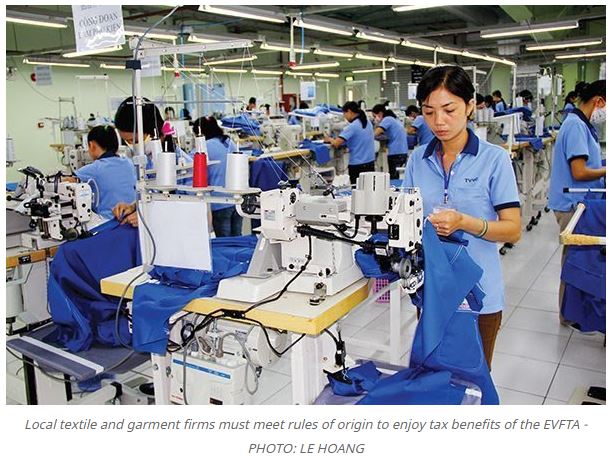Vietnam apparel firms won’t see instant benefits from EVFTA
Vietnamese apparel companies will not enjoy immediate tariff cuts after the EU-Vietnam Free Trade Agreement (EVFTA) comes into effect, as they have to overcome strict rules of origin.
Under the deal, Vietnam’s footwear, textile and garment industries will have to make changes to meet the conditions of origin and take advantage of preferential tariffs. For the textile and garment industry, fabrics used to make the products must originate from Vietnam or the EU, and the cutting and sewing must be performed in either the bloc or Vietnam.
Thanh Cong Textile Garment Investment Trading Company (TCM) is now subject to an average tax rate of 12% in the EU market. When the free trade deal becomes effective, TCM targets to raise the export ratio in the market to 12%-15% from the current 5%-8%, focusing on products immediately applicable with a 0% tax rate.
Tran Nhu Tung, a board member and deputy general director of TCM, is confident that some of TCM’s products will benefit from EVFTA’s preferential taxes, as the enterprise is also a yarn and fabric producer. Besides this, local enterprises will increase the purchase of TCM products to replace imports from China.
Currently, TCM is expanding fabric production to grab more opportunities from the deal, Tung added.
Pham Van Viet, chairman of Viet Thang Jean Company, said its products will become more competitive in the EU market given the 0% tax rate, compared with the current levels from 14% to 18%. The enterprise has shifted its cloth supplies from China to Thailand and South Korea, which have signed an FTA with the EU.
According to the General Statistics Office, Vietnam’s apparel exports hit US$32.85 billion last year, in which goods worth only US$4.3 billion were shipped to the EU. Therefore, the deal is expected to give a boost to Vietnamese apparel exports in the market.
However, unlike TCM and Viet Thang Jean, Vietnamese firms still face several challenges because most of them have only just engaged in cutting and sewing and do not produce fabric and yarn.
To deal with the cloth fabric and approach the EVFTA, some enterprises have shifted to importing fabric from South Korea, which is more expensive than that imported from China and Taiwan. As a result, local firms would fail to gain huge benefits despite the tax incentives of the EVFTA.
Further, local firms still find it hard to develop local material supplies due to environmental concerns. In recent years, many localities have rejected new garment and dyeing projects to avoid adverse impacts on the environment. SGT
Le Hoang
Source: https://vietnamnet.vn/en/business/vietnam-apparel-firms-won-t-see-instant-benefits-from-evfta-652451.html


 English
English




